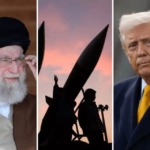A dramatic scene unfolded in the heart of Moscow that could’ve been ripped from a spy thriller: one of Russian President Vladimir Putin’s luxury limousines burst into flames, sparking a firestorm of speculation and intrigue. As of April 2, 2025, the incident has gripped global attention, blending high-stakes drama with unanswered questions about security, sabotage, and the Kremlin’s iron grip. Here’s what we know—and what we don’t—about this explosive event.
The Blaze Ignites
On March 29, an Aurus Senat limousine part of Putin’s official fleet—erupted in a massive fireball on Sretenka Street, just blocks from the headquarters of Russia’s FSB security service in Lubyanka. Video footage circulating online shows thick black smoke billowing from the £275,000 ($356,000) armored vehicle as flames consumed it, starting in the engine and rapidly spreading to the interior. Bystanders from nearby bars and restaurants rushed to help before fire crews arrived, extinguishing the blaze that left the car a charred husk. Thankfully, no injuries were reported, but the damage was done—both to the limo and to the Kremlin’s sense of invulnerability.
The Aurus Senat, a symbol of Russian prestige and Putin’s personal taste, is no ordinary ride. Heavily armored and custom-built, it’s a staple of his motorcade and a gift he’s bestowed on allies like North Korea’s Kim Jong Un. That one of these elite vehicles went up in flames so close to the FSB’s nerve center has set tongues wagging.
Assassination or Accident?
The million-ruble question: What caused the explosion? Initial reports from outlets like GB News and Euro Weekly News suggest a mechanical failure might be to blame—a plausible explanation for a car catching fire. Yet, the timing and location have fueled rampant speculation of foul play. Posts on X and media like The Sun quickly spun tales of an assassination attempt, tying it to Putin’s paranoia over security amid the Ukraine war. The Kremlin’s silence—over 72 hours with no official comment as of April 2—has only deepened the mystery.
Adding to the intrigue, this incident follows heightened security measures around
Putin. Just last week, Federal Protective Service (FSO) officers were seen scouring sewers and patting down ceremonial guards before a speech in Murmansk, a sign of the 72-year-old leader’s growing fear of threats. Ukraine’s military intelligence chief, Kyrylo Budanov, has claimed multiple assassination attempts on Putin in recent years, while Russia’s parliament speaker, Vyacheslav Volodin, warned that any such plot could trigger a nuclear response. Against this backdrop, a limo explosion near the FSB feels less like a coincidence and more like a warning shot—intended or not.
The Kremlin’s Tightrope
If this was sabotage, it exposes cracks in Putin’s fortress. The Aurus fleet, managed by the Presidential Property Management Department, is under tight control, raising questions about how an attack could penetrate such a secure circle. Was it an inside job, a Ukrainian operation, or a message from a domestic foe? The lack of casualties and the car’s apparent emptiness at the time suggest it might not have been a direct hit on Putin himself, but the symbolism is undeniable—a blazing limo in Moscow’s core is a bold affront to his authority.
Conversely, if it was just a mechanical glitch, it’s an embarrassing hiccup for Russia’s vaunted engineering. The Aurus brand, launched to rival Western luxury cars, is a point of national pride. A spontaneous combustion doesn’t exactly scream reliability, especially for a leader who projects unassailable strength.
Global Echoes
The timing couldn’t be more charged. Russia’s war in Ukraine grinds on, with Putin rejecting a full U.S.-brokered
ceasefire while agreeing to a limited pause on energy strikes after a March 18 call with President Donald Trump. Meanwhile, Trump’s envoy, Steve Witkoff, met with Russian officials in Moscow on March 27, pushing for peace talks. A car fire—accidental or not—adds a layer of chaos to an already tense diplomatic dance, amplifying Kremlin paranoia as it juggles external pressure and internal control.
What’s Next?
As investigators sift through the wreckage, the world waits for answers. Was this a freak accident or a calculated strike? The Kremlin’s reticence suggests it’s still weighing how to spin the narrative—downplay it as a technical fault or inflate it into a rallying cry against enemies. For now, the charred limo stands as a potent symbol: even in Putin’s Moscow, nothing is fireproof.







